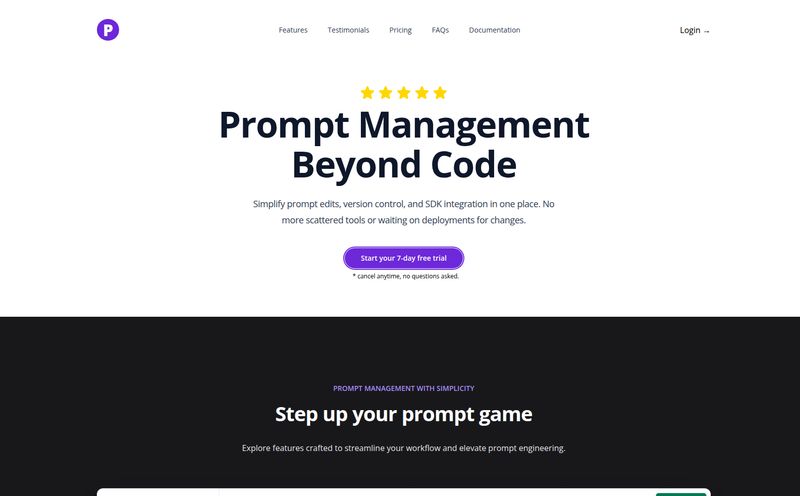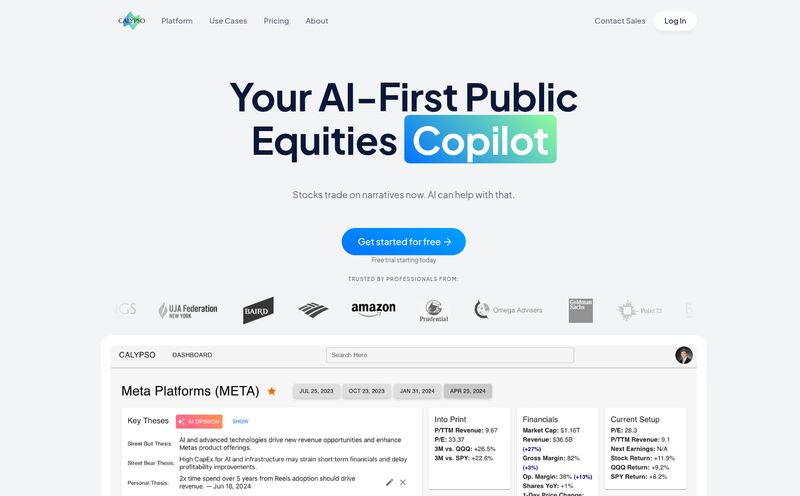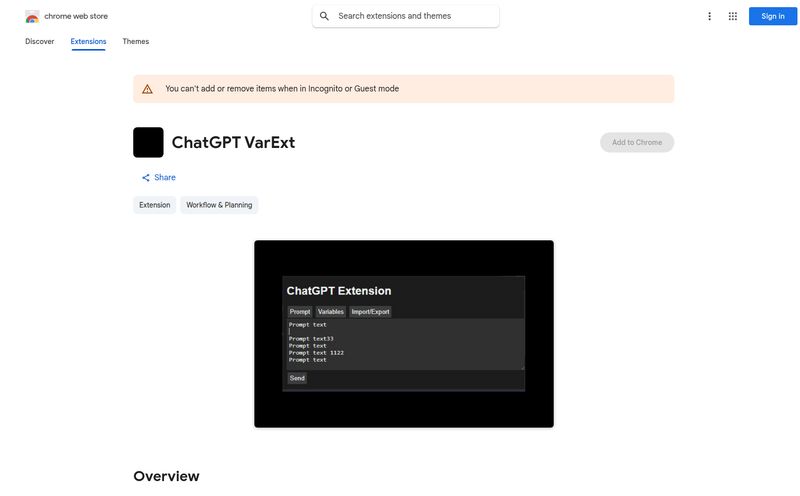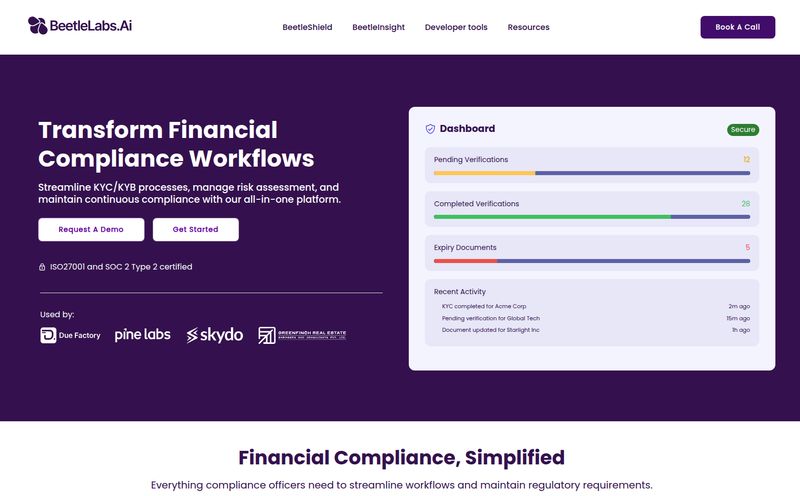Let’s have a little heart-to-heart. If you've ever been in the trenches of digital marketing, SEO, or development, you’ve probably got some war stories about web scraping. I know I do. I remember one particularly soul-crushing week trying to pull product data from a site built with some obscure JavaScript framework. My scripts kept breaking, my IP got flagged, and my coffee consumption reached alarming levels. It was a classic cat-and-mouse game, and the mouse was winning.
The whole process is often a messy, thankless job. You’re either wrestling with headless browsers that eat RAM for breakfast or getting tangled in a web of proxies and CAPTCHA solvers. So, when I hear about a tool that claims to handle all “the hard stuff,” my ears perk up. But I'm also skeptical. I’ve been burned before.
That's the lens through which I started looking at Firecrawl. The headline on their site is bold: “The web crawling API.” It’s not just about scraping; it’s about turning the chaotic, unstructured mess of the internet into clean, “LLM-ready” data. In a world where everyone and their dog is building some kind of AI application, that’s a pretty compelling pitch.
So, What Exactly is Firecrawl? (And Why Should You Care?)
Alright, let's cut through the jargon. At its core, Firecrawl is an API that does one thing incredibly well: it goes to any website you tell it to, grabs all the content, and gives it back to you in a neat, organized format. Think of it as a highly-skilled data extraction team you can hire with a single line of code.
But the real magic is in that “LLM-ready” part. What does that even mean? It means instead of getting a jumble of raw HTML tags, you get clean Markdown. This is perfect for feeding directly into Large Language Models (like the GPT series) for things like building a custom chatbot on your company’s knowledge base or performing market analysis. It strips away all the noise—the ads, the navigation bars, the weird tracking scripts—and just gives you the meat. The actual content.
And here’s the kicker for people like me who value transparency: it's open-source. You can go look at the code on GitHub. This isn't some black box where you send a URL and pray. This builds a ton of trust and means if you’re a serious developer, you can even customize it or host it yourself. That's a huge plus in my book.
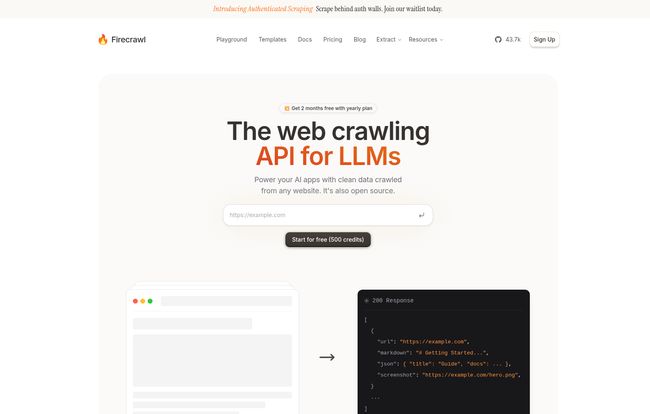
Visit Firecrawl
The Features That Genuinely Matter
Any tool can list a dozen features on its homepage. But what are the ones that actually save you from pulling your hair out? After playing around with Firecrawl, a few things really stood out.
It Tames the Wild West of Dynamic Websites
The modern web runs on JavaScript. Sites built with frameworks like React, Vue, or Angular load their content dynamically, which is a total nightmare for old-school scraping tools. They just see a blank page. Firecrawl, however, uses a proper headless browser behind the scenes. It waits for all that JavaScript nonsense to finish running and renders the full page before it starts scraping. This means you actually get the data you’re after, not just the loading spinner's HTML. This single feature is worth its weight in gold.
Forgetting about Proxies and Rate Limits
If you've ever tried to scrape a site at scale, you've met the dreaded 429 “Too Many Requests” error. Big sites are smart; they know when a single IP address is hitting them too hard and they'll block you in a heartbeat. The typical solution is to buy and manage a list of rotating proxies, which is its own special kind of headache. Firecrawl handles all of this for you. It automatically rotates its IP addresses and manages request rates to avoid getting blocked. You don't even have to think about it. It just works. What a concept!
Data on Your Terms: Markdown, JSON, and More
Flexibility is everything. Firecrawl doesn't just give you a wall of text. You can ask for the output in a few different, super-useful formats.
- Markdown: As I mentioned, this is perfect for feeding context to an LLM. It's clean, readable, and structured.
- JSON: Need structured data? You can define a schema and have Firecrawl extract specific elements from the page—like product names, prices, and reviews—and return it all in a perfect JSON object. This is a massive time-saver for any data-driven application.
- Screenshots: Sometimes you just need to see what the page looks like. This is great for archival purposes or for visual change detection.
- Media Parsing: This is a newer addition and it's pretty neat. It can identify and extract images and other media from a page, which opens up some interesting possibilities.
Let’s Talk Turkey: The Firecrawl Pricing Model
Okay, this is the part everyone secretly scrolls down to first. How much is this going to cost me? The pricing is based on a credit system, which is pretty common for APIs. I’ve put together a simple table to break it down, since their pricing page is pretty comprehensive.
| Plan | Price | Credits per Month | Best For |
|---|---|---|---|
| Free | $0 | 500 | Testing and small personal projects. |
| Hobby | $16/month (billed yearly) | 3,000 | Serious hobbyists or early-stage startups. |
| Standard | $83/month (billed yearly) | 100,000 | Small to medium-sized businesses with regular data needs. |
| Growth | $333/month (billed yearly) | 500,000 | Companies scaling their data operations. |
Understanding the Credit System
This is important. Not all actions are created equal. A simple scrape is cheap, but asking for more complex work costs more. Here’s the gist:
- Scraping a single URL: 1 credit
- Crawling a website: 1 credit per page crawled
- Structured Extraction (JSON): 5 credits per request
So, if you crawl a 50-page website, that’s 50 credits. If you scrape one page and ask for structured data, that's 5 credits. It’s a fair system that scales with the complexity of your request, but you do need to keep an eye on it so you don't burn through your monthly allotment by accident.
My Take: Where Firecrawl Shines (and Where It Stumbles)
No tool is perfect. After using it, here's my honest opinion. Firecrawl absolutely shines for developers building modern AI apps. If you're creating a RAG application, this tool feels like it was designed specifically for you. The developer experience is smooth, the documentation is clear, and it just… works. It removes so much of the traditional friction associated with web scraping that it almost feels like cheating.
Where might it stumble? If your project is incredibly high-volume but very low-margin, the credit-based system could add up. Scraping millions of simple pages might be cheaper if you build and maintain your own infrastructure, if you have teh expertise and time to do so. Also, while the structured data extraction is powerful, at 5 credits a pop, you'll want to be strategic about when you use it. It's not a flaw, just a cost to be aware of.
Who is Firecrawl Actually For?
I see a few key groups getting a ton of value here.
- AI/ML Developers: This is the bullseye. Anyone building apps that need to understand and process information from the web is the primary audience. RAG, content summarization, market intelligence bots—you name it.
- Data Scientists: Need to gather a clean dataset from a dozen different sources without spending a month writing custom parsers for each one? This is your tool.
- SEOs and Marketers: I'm thinking big here. Imagine crawling all your competitors' blogs, turning them into clean text, and feeding them to an LLM to identify content gaps and strategic opportunities. Or monitoring SERPs at scale without getting your IP banned. The potential is huge.
Frequently Asked Questions
Is there really a free version of Firecrawl?
Yep! There's a Free Plan that gives you 500 credits per month. It's a great way to try out the API and see if it fits your project without pulling out a credit card.
What's the difference between the 'scrape' and 'crawl' functions?
Think of it this way: 'scrape' is for a single page. You give it one URL, it gives you back the content of that one page. 'Crawl' is for a whole website. You give it a starting URL, and it will follow the links to discover and scrape multiple pages on that site.
Can Firecrawl handle sites that need a login?
Yes, according to their documentation, you can provide authentication details like cookies or headers with your API request. This allows it to scrape content that's behind a login wall, which is a powerful feature.
What happens if I run out of credits?
Your requests will start to fail until your credits reset the next month. However, they offer add-ons like Auto Recharge or one-time Credit Packs so you can buy more if you're running a big job.
Do my unused credits roll over to the next month?
Based on the standard subscription model, monthly credits typically do not roll over. They reset at the beginning of each billing cycle. You'd use the credit packs for extra, non-expiring credits.
Does it handle CAPTCHAs and other bot detection?
Firecrawl is designed to handle many of the common anti-scraping challenges automatically, including things like CAPTCHAs, through its sophisticated proxy and browser management system. For the vast majority of public websites, this should be handled for you.
Is Firecrawl the Future of Web Data Extraction?
Look, calling anything “the future” is a bit much. But Firecrawl is a massive step in the right direction. It takes a notoriously difficult, frustrating task and makes it accessible through a clean, modern API. It’s not just a scraper; it’s a data refinery built for the age of AI.
It won't be the perfect solution for 100% of use cases—nothing ever is. But for developers, data scientists, and even savvy marketers who want to tap into the web's vast repository of information without the usual headaches, it's an incredibly powerful and well-timed tool. It lets you focus on what you actually want to do with the data, rather than on the painful process of getting it.
And for me, that's a win. A big one.
